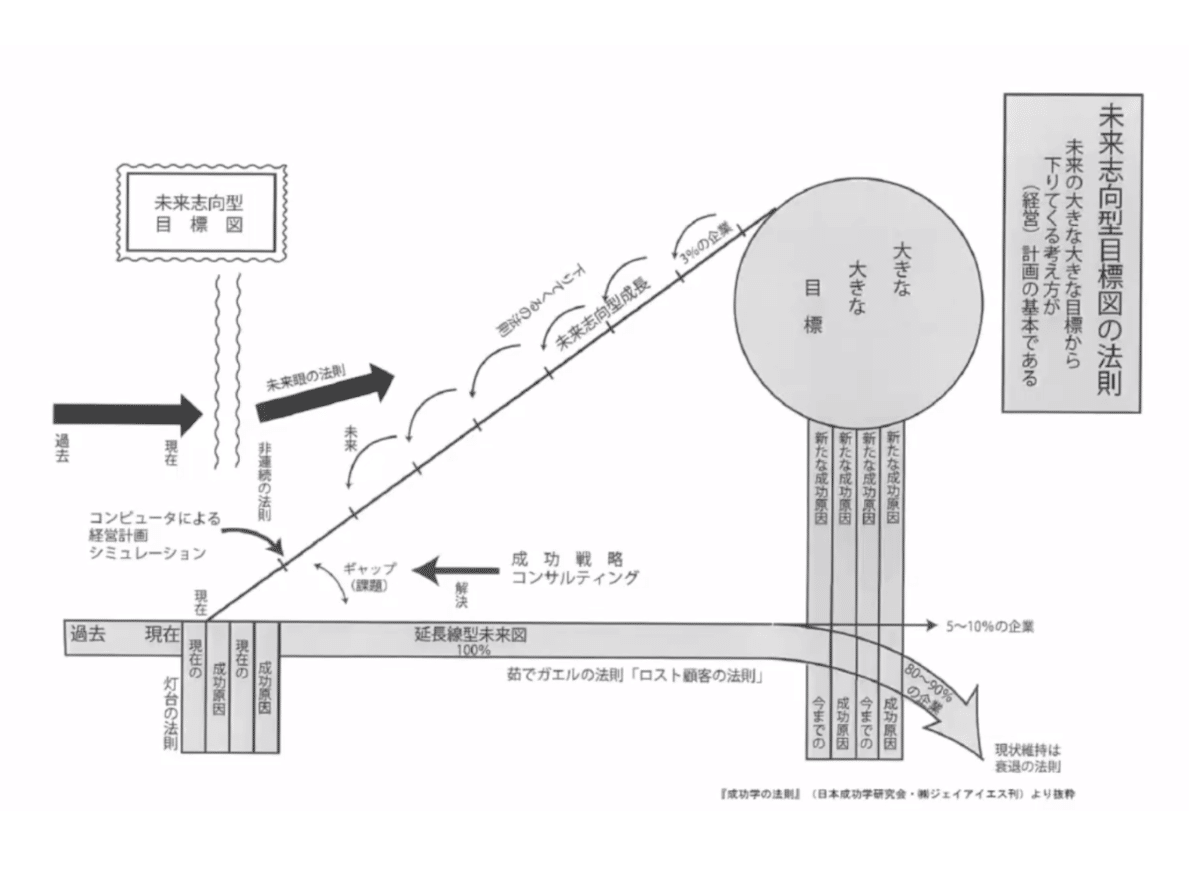時は未来からも流れてくる Time Also Flows from Future 시간은 미래에서도 흘러온다
地球上のどこでも、川は上流から下流へと向かい、海へと流れ出ていきます。もしあなたが船の上に乗って川に流されていたら、上流は「過去」で下流は「未来」になるでしょう。
しかし、あなたが船から降りて岸辺に立てば、「未来」は上流にもあると気づくはずです。すでに目の前を通り過ぎた水が下流にあるという視点で見れば、下流は「過去」になります。そして現時点で上流にある水はいずれ目の前にやってくると考えれば、上流は「未来」と言えるからです。
その視点に確信を与えてくれたのが、元UNESCO事務局長顧問の服部英二さんです。服部さんはある講演の最後に「若手の皆さん、希望を持ってください。時は未来から流れます」とおっしゃったのです。
川下りを人生に置き換えると、自分がまわりの人や社会の常識に流されて生きているうちは、「未来」は現在の延長線上にあるものでしかありません。しかし、自分自身が明確な意志を持ち、主体的に生きようという意識を持って岸辺に立てば、「未来」は自分の方へと向かってくる存在にもなり得ます。つまり、「未来」を定めることで「現在」が形作られていくのです。
この「時は未来からも流れる」という視点は、未来から逆算して現在を考える「俯瞰逆算」という考え方と深く結びついています。俯瞰逆算は、私が25歳のときに稲盛和夫さんが主催する経営塾(盛和塾)でフェリシモ創業者で京都フォーラム理事長の矢﨑勝彦さんから学んだものです。盛和塾の塾長・稲盛さんは、一代で一兆円企業を二社(京セラとKDDI)つくりあげられた方です。近年では、日本において過去100年間で最も多額の負債を抱えて事実上倒産した航空会社JALの再建に無給で挑み、2年ほどで再上場へと導いた経営手腕をもつ、世界を代表する経営者のお一人で、ソフトバンクの孫正義さんもかつて盛和塾で学ばれていたようです。その稲盛和夫さんの公共的な功績の1つに盛和塾があり、その発起人として塾の根幹をつくり、世界展開をリードされたのが矢﨑勝彦さんです。
19歳で起業して以来、私は「現在の積み重ねが未来につながる」という考え方で会社を経営していました。明確な目標やビジョンを持たず、売上や利益が増えたか減ったかといった、目の前の結果に一喜一憂していたのです。そんな私にとって、矢﨑さんから学んだ俯瞰逆算の考え方は目から鱗でした。
また、「俯瞰逆算」が企業経営において有効だと裏付けるデータがあります(以下画像参照)。公認会計士のグループが世界の企業を分析した結果、永続的発展を成し遂げている3%の企業だけが「俯瞰逆算」経営を取り入れていることがわかりました。一方で、80-90%の企業は、現時点での成功の方程式にしたがって未来に向かうので、イノベーションが起きず、いずれ衰退していく運命にあります。
25歳のときから「俯瞰逆算」を信じ、自身の会社で実践した結果、5年連続で100%成長(売上が前年の倍)を果たしたという実体験が、私の確信をさらに深めてくれました。だからTYPICAでは、「世界一のダイレクトトレードマーケットをつくる」という2030年までの目標を、具体的な数値とともに設定しているのです。

Time Also Flows from Future
No matter where you are in the world, rivers flow from upstream to downstream until they merge with the sea. Imagine yourself on a boat, floating down the river. The upstream disappears into the past as the water carries you downstream toward the future.
But if you step off the boat and stand on the shore, you realize that the upstream is not just your past: It could also be your future, too. On the other hand, the downstream could be considered your past, because the water has already passed you by and is now behind you. From this perspective, the upstream represents your future, as it is constantly flowing towards you and will eventually reach you.
My belief in this perception of time was further solidified when I attended a talk by Mr. Eiji Hattori, former advisor to the Secretary General of UNESCO. At the end of his speech, Mr. Hattori offered an inspiring message for the younger members of the audience: “Be hopeful, for time also flows from the future.”
Let me apply this analogy of a boat ride to life. If you simply follow conventional wisdom and accept the status quo, then your future is nothing but a mere continuation of your present. But if you live your life intentionally and with purpose, you can put yourself on the shore and let the future flow toward you. In other words, defining your own future, of your own will, can shape your present.
The idea that time also flows from the future is closely connected with the concept of “thinking backwards from the future”. I first learned about this idea when I was 25 years old, at an entrepreneur school called Seiwa-juku, founded by the late Kazuo Inamori. Mr. Inamori was a world-renowned entrepreneur who built Kyocera and KDDI into businesses worth over one trillion yen (about 7.5 billion dollars) in his lifetime. More recently, he led the successful restructuring of Japan Airlines (JAL) without pay after the company effectively went bankrupt with the largest debt in the past 100 years of Japan’s corporate history. But in just two years, Mr. Inamori managed to take the company public again. By the way, Masayoshi Son of SoftBank is also a former student of Seiwa-juku.
When I started my first business at 19, I thought that my daily efforts and hard work would eventually shape my future. I was preoccupied with short-term results and the fluctuation of sales and profits without any clear goal or long-term vision. But the concept of “thinking backwards from the future” was a revelation for me, as it allowed me to shift my focus from the present to the bigger picture.
There is some data that supports the effectiveness of “thinking backwards from the future” in business management (see image below). According to an analysis of businesses worldwide conducted by a group of certified accountants, only 3% of the surveyed companies have experienced sustainable growth. The difference between these companies and the rest was that they adopt the concept of “thinking backwards from the future.” Meanwhile, 80-90% of companies continue to follow their existing formula of success, which stifles innovation and may lead to their eventual decline.
When I was 25 years old, I started practicing the concept of “thinking backwards from the future.” As a result, my business saw a consistent year-on-year doubling of sales for five straight years. This experience further cemented my belief in the power of this approach. This is why at TYPICA we have set a goal of “creating the world’s No.1 direct trade market by 2030,” along with specific, quantifiable targets.
시간은 미래에서도 흘러온다
지구상 어디서나 강은 상류에서 하류를 향해 가고, 바다로 흘러갑니다. 만약 당신이 배를 타고 강을 떠내려가고 있으면 상류는 ‘과거’이고 하류는 ‘미래’가 될 것입니다.
그러나 당신이 배에서 내려 물가에 서면 ‘미래’는 상류에도 있다는 것을 알게 될 것입니다. 이미 눈앞을 지나간 물이 하류에 있다는 관점에서 보면 하류는 ‘과거’가 됩니다. 그렇게 현시점에서 상류에 있는 물이 언젠가 눈앞에 온다고 생각하면 상류는 미래라고 할 수 있기 때문입니다.
이러한 관점에 확신을 준 것이 전 UNESCO 사무국장 핫토리 에이지 씨입니다. 핫토리 씨는 한 강연 말미에서 ‘청년 여러분, 희망을 가져 주세요. 시간은 미래에서 흘러옵니다’고 말씀하셨습니다
강을 타고 내려가는 걸 인생에 대입해보면 자신이 주위 사람이나 사회의 상식에 떠밀려 사는 동안에는 ‘미래’는 현재의 연장선상에 있는 것일 뿐입니다. 그러나 자기 자신이 확고한 의지를 가지고 주체적으로 살아가고자는 의식을 갖고 강가에 서면 ‘미래’는 자신을 향해오는 존재가 될 수도 있습니다. 즉 ‘미래’를 정함으로써 ‘현재’가 형성되어 가는 것입니다.
이 ‘시간은 미래에서도 흘러온다’라는 관점은 미래에서부터 역산하여 현재를 생각하는 ‘부감역산(俯瞰逆算)’이라는 사고방식과 깊게 연결되어 있습니다. ‘부감역산’은 제가 25살 때 이나모리 가즈오 씨가 주최한 경영 아카데미 세이와주쿠(盛和塾)에서 배운 것입니다. 세이와주쿠의 아카데미장 이나모리 씨는 당대에 시가총액 일조엔 기업 두 곳(교세라와 KDDI)을 설립하신 분입니다. 최근에는 일본에서 지난 100년 사이에 가장 많은 부채를 안고 사실상 도산한 항공사 JAL의 재건에 무보수로 도전했으며, 2년 정도 만에 재상장으로 이끈 경영 수완을 가진 세계를 대표하는 경영자 중 한 사람입니다. 참고로 소프트뱅크의 손정의 씨도 예전에 세이와주쿠에서 공부했습니다.
19살 때 창업한 이후 저는 ‘현재의 축적이 미래로 이어진다’는 생각으로 회사를 경영했었습니다. 뚜렷한 목표와 비전 없이 매출과 이익이 늘었는지 줄었는지 하는 눈앞의 결과에 일희일비하고 있었던 것입니다. 그런 저에게 세이와주쿠에서 배운 부감역산의 사고방식은 새로운 발상이었습니다.
또한, ‘부감역산’이 기업 경영에 있어 유효하다고 뒷받침하는 데이터가 있습니다. 공인회계사 그룹이 세계의 기업을 분석한 결과에 의하면, 영속적으로 발전을 이루고 있는 3%의 기업만이 ‘부감역산’ 경영을 도입하고 있는 것으로 나타났습니다. 한편, 80-90%의 기업은 현시점의 성공 방정식에 따라 미래를 향해 나가기 때문에 이노베이션이 일어나지 않고 머지않아 쇠퇴할 운명에 있습니다.
25살 때부터 ‘부감역산’을 믿고 자신의 회사에서 실천한 결과, 5년 연속으로 100% 성장(전년 매출의 배)을 달성했다는 실제 경험이 저를 더욱 확신시켜 주었습니다. 그래서 TYPICA에서는 ‘세계 제일의 다이렉트 트레이드 마켓을 만들겠다’는 2030년까지의 목표를 구체적인 수치와 함께 설정하고 있는 것입니다.
この記事が気に入ったらサポートをしてみませんか?
